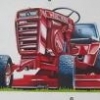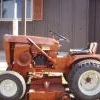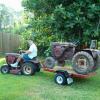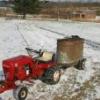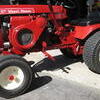Leaderboard
-
in all areas
- All areas
- Markers
- Marker Comments
- Marker Reviews
- Articles
- Article Comments
- Article Reviews
- Classfieds
- Classified Comments
- Classified Reviews
- Wiki's
- Wiki Comments
- Wiki Reviews
- Blog Entries
- Blog Comments
- Images
- Image Comments
- Image Reviews
- Albums
- Album Comments
- Album Reviews
- Files
- File Comments
- File Reviews
- Posts
-
Today
-
All time
November 28 2011 - December 26 2025
-
Year
December 26 2024 - December 26 2025
-
Month
November 26 2025 - December 26 2025
-
Week
December 19 2025 - December 26 2025
-
Today
December 26 2025
- Custom Date
-
All time
Popular Content
Showing content with the highest reputation on 12/26/2025 in all areas
-
9 pointsBefore someone mentions it, yes the 8N came out unofficially in 1947. While most will tell you the 8N was from 1948 through 1952, the first 8Ns were sold in 1947 and there are a few design characteristics that a 1947 has that a 1948 doesn't. They are explained in my youtube video here, and also explains why this is not a 1950-1952 side mount tractor: I got this tractor in the summer of 2021. Since this came out of the factory as a front mount engine, things were done to it to convert it to a side mount engine. Different timing cover, different cam gear, i.e. that allowed the front mount distributor to be thrown away and a side mount distributor to be added. As explain in the video, the front mount engines had the generator (in this case alternator) on the right side, but to convert this to a side mount, the distributor goes on the left side. So the alternator was moved to the left side with a funky looking home made bracket. A true side mount distributor had the oil filler tube moved rearward slightly to make room for the generator, whereas this one being a front mount engine, the oil filler tube was just smashed against the engine block to accommodate the alernator. Being that this was a homemade side mount conversion, when I got it, it didn't run right. So we put it in time and now it runs good. The fan shroud was trashed, so a new fan shroud, as well as a new radiator. Also new steering wheel was added as well as a new grille. After power washing, the first coat of red went on in the spring of 2022. Light grey was added to the wheels and fenders and doglegs, as well as the new grille. But since I don't do body work and my bil does, he took the hood and was supposed to work on it. He had it for 3 and half years, and I finally got it back a couple of weeks ago. So, now the hood can be painted. Along the way, I replaced the pto seal since it was leaking. It still needs the left rear axle seal replaced. And I want to get a new battery door latch. The almost finished product is more of a 50 foot paint job (maybe 50 yards....). It is almost there. Since the red paint was added, it sat in the garage so, it now needs powered washed to get the red to shine again.
-
9 pointsAfter a year of sweat, tears, and help from the forum. I'm done (enough) for now. After a few dicky electrical gremlins which I thought were solved, its not starting reliably, and ready to be put through it paces. And then in a year, I'll fix all the other stuff I'm not happy with.
-
7 points
-
6 pointsA Briggs spark checker, Knipex pliers and a Taryl t-shirt. And I really wasn't that good this year!
-
6 pointsToday I towed the C-141 back home, from my brothers next door after the battery went dead. Everything went fine, and it just slid along on the snow. The gradual hill beside my brothers house was a bit tricky with brakes that stopped but the tires still slid, no mishaps though. The 308 with the plow came in handy getting it in the basement garage/workshop once I got there. Tomorrow I'll charge it up and test it out. I might get some seat time plowing on the 308 as we got a significant amount of snow since yesterday.
-
6 pointsI didn't get a damn thing ... guess I just go out and get myself somethin. Best you keep an eye on them step bits Sylvia ... Pulstart around...
-
5 points
-
5 points
-
5 pointsMerry Christmas from the PeacemakerJack family. This is Coulter Caleb’s new house and his fiancée Faith (sitting on her 314H) along with the rest of our family. We started taking these Christmas tractor pictures 11 years ago…a lot has changed since that first picture. I’m so thankful for the many memories made through the years. As Tiny Tim observed, “God bless us…every one!”
-
5 pointsPictured below is a gift and card (on nothing less than notebook paper.) my ten year old granddaughter gave me. She told me she bought me a Christmas gift (with her own money her mom said.) a couple of weeks ago. The school had some kind of sale and Gracelia found these pliers and snatched them up. The other side of the card said "TO: You FROM: Cece" These pliers will not likely be put to use on the 520H. They, along with the card, will be hanging on my "wall of memories" in the shop and remain there as long as I'm able to be out there tinkering around.
-
4 pointsGreat minds think a like. Got Dewalt inflater and locknflate from Santa. The inflater was inspired by someone at the big show you know who you are @squonk .
-
4 pointsOn December twenty sixth take them off the tree and celebrate National Candy Cane Day. Get hooked on these minty confectionery, sample different flavors or use them to enhance other sweet treats like hot chocolate and cookies. Candy canes can also remind us of the memories we had as a child. Simply opening the wrapper can take you back to special moments that you shared with your family. Check out a few of these ideas for celebrating National Candy Cane Day.
-
4 pointsTransmission is back together just working on getting the old paint off so I can paint it and have to do some welding on the frame
-
3 pointsThis morning a balmy 8 degrees predict 7 inches of snow starting after lunch
-
3 pointsSanta decided I should address all of my janky battery cables.
-
3 points
-
3 points
-
3 points
-
3 pointsY'all are missing the biggest clue as to this Wheel Horse's model number and year of manufacture. The "Rust-Oleum muffler was only used on one mode, but I can't remember which one it was.
-
3 points
-
3 points
-
3 points
-
3 pointsYes. I also know both parts of The Second Week of Deer Camp, and The Turty-point Buck.
-
3 pointsBraid that is one fine looking B 100. In my book that was the pinnacle of wheel horse engineering I know I will get a hairy eyebrow on that one, but I just feel these were the best engineered wheel horses, simple in design very rugged. As they say just my two sets. . Hope every buddy had a good Christmas.
-
3 pointsMade new plug wire for c160 in between family engagements’.
-
3 pointsI still have the 1963 test that the shop teacher marked me wrong when I called that thing a slip joint pliers.
-
3 pointsA nice sign. Some tooling for the lathe that I recently purchased and a tool box that will be dedicated to lathe tools.
-
2 points
-
2 points@JimD would have been 74 today. He was taken too soon and we miss him dearly. His humor was infectious and he was always there to offer a suggestion or helpful hint. In memory of JimD, caption this.
-
2 pointsIt is NOT a 1055 or anything else ending in a 5. It is not a 1056 or anything else ending in a 6. Both of those years used the short oil pan so it is obviously not an 1965 or 1966 model. The 1967 models had the hood hinge and tower raised enough to allow the use of the K-241s or K-301S which is what this has as pictured,
-
2 points" Da Yoopers! " I listen to the Packer games on XM when they aren't televised here. Years ago I could get the games on WTMJ online. All of the commercials sounded like Da Yoopers were doing them!
-
2 pointsThat amount would be INCREDIBLY small. I've driven tankers. Modern tankers are unloaded from the bottom. They're also extremely careful to be sure there's absolutely minimal mixing of any kind. The minimum tank pocket size is close to a thousand gallons. A few teaspoons of laced fuel in a tank of a thousand gallons would be of no effect. Many trucks even have dedicated tanks specifically for each type of fuel.
-
2 pointsThat can be a good thing, just remember that ethanol free can have a water freezing problem if you get water in the system and E10 gas can handle a considerable amount of water. I snowmobiled for many years and got gas wherever it was available along the trails, water in fuel happened a number of times. I carried dry gas and it often did save the day. My worst case was in Idaho where I stayed at a marina and used their gas. That gas had an enormous amount of lake water in it due to faulty plumbing. Dry gas got me thru the day and when I arrived back at the marina the folks their came out to tell me the problem and drained my tank which still had nearly 50% water. Other than sounding weird and causing my eyes to burn and water it ran reasonably well, if someone were to tell me it could run at all with that much water I would not have believed them. Although I did say that dry gas is obsolete you do need to be aware that water contaminated ethanol free gas can be an issue.
-
2 points
-
2 pointsUgh, thanks. ( I think) ) LOL Might as well spit ball one then! Personally I would do the wings on a 45 deg angle from the main blade and made with pieces of an old blade. Welded on with additional supports. This way the blade could still be used on an angle to move snow to one side or the other and also be used as a pusher to collect larger amounts vs a straight blade. Or even more complicated by making them adjust from flat to a 45 angle.
-
2 pointsOn our way to pick up my 420-LSE in Ohio in 2021 we stopped at the Christmas Story House. It was in the beginning of October in the middle of the week. I remember thinking that we probably would be the only ones there, wrong! There was a half hour wait to go inside because the line was so long! I couldn’t believe it. Seeing it first hand was pretty cool I must admit. I purchased a book on the movie from the gift shop across the street which has all kinds of fun facts about the movie. The fire truck is stored across the street from the house, and although it is not the exact truck that was used in the movie it is a great replica.
-
2 pointsEverything needed to save a New Tee Body hydrate....works better than those hospital IVs.
-
2 points4 tires to my doorstep shows $60. That isn't bad at all. But that is more to ship the tire than the cost of the tire. Side note: 4 tires ship for the same as 1 tire. The calculator kicks higher only after 6 tires...
-
2 points
-
2 pointsNot much. Some paint and primer and some 58087's for rebuilding carbs. Maybe next week a 1991 310 complete roller minus deck but with a blown motor. Lots of good parts though. RK gift cards later today I am sure.
-
2 pointsLock n flate adapter for tires, New Milwaukee batteries and a tractor seat with adjustable base.
-
2 points
-
2 pointsMy wife had our neighbor (Mifflintown Metal Works) make me this shop sign for Christmas! Love it!!
-
2 pointsWhile the experts prognosticate on the tractor's original pedigree, please post the seat in the ugly seat thread. It has a very nice green patch... every little bit helps with global warming...
-
2 points🙄 As we are all to well aware... marketing works whether you need a refrigerator in the Arctic or not.
-
2 points2025 turf wars to be continued in 2026. . Have to keep eye on @cafoose also. .
-
1 pointThe stations around here that has ethanol free has dedicated pumps for it. I used to drive tankers as well and agree we unloaded them out clean as a whistle.
-
1 pointI wholeheartedly agree. If you have access to ethanol-free gas, you have all you need. It's expensive, but worth it. And if it is dispensed from the same pump as ethanol fuel, run the first gallon (or two) into your vehicle. Otherwise you have a blend of ethanol and ethanol free in your gas can. I've seen old trucks pulled from a barn with 1/4 tank of old gas in them, after setting for years that start and run with a jump. Good luck with ethanol fuel that is 90 days old.
-
1 pointGuessing's over it's a a 10 0r 1257 fer sure. What yer plans for it? Even with the chunks missing that steering wheel is definitely restorable.
-
1 pointMaybe we can agree to setting some boundaries....nah, probably not
This leaderboard is set to New York/GMT-05:00
-
Newsletter









